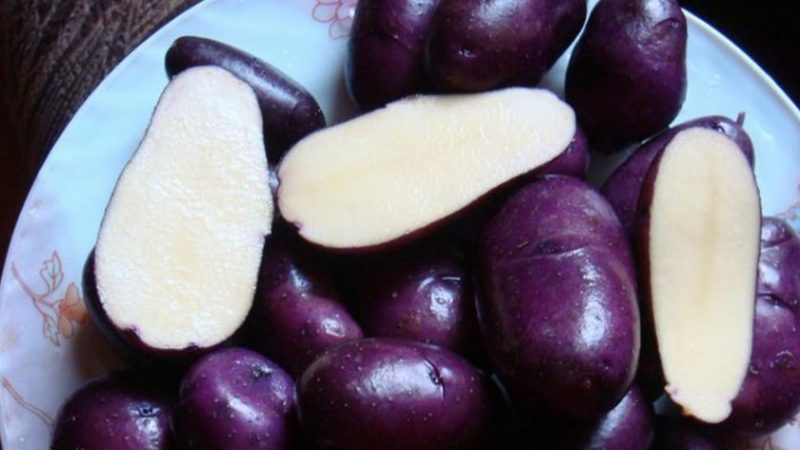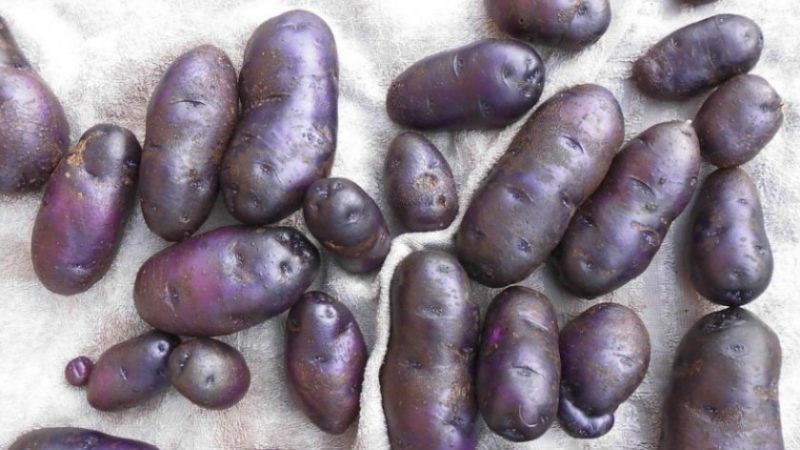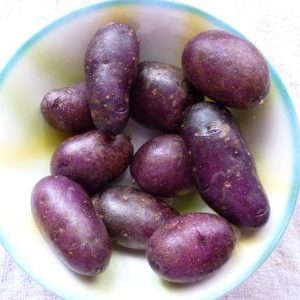Amateur table potato variety "Gypsy" with purple skin and white pulp
Many growers love to experiment by growing unusual crops. Potatoes also have varieties with an exotic appearance of tubers.
Gypsy potatoes are one of those interesting varieties. It is distinguished by tubers with a dark purple rind. The Gypsy woman conquers not only with an unusual appearance, but also with a delicate taste and rich aroma. For this, gardeners forgive her even the exactingness of care and low transportability. Read about other advantages and disadvantages of this variety, as well as the nuances of agricultural technology, below.
The content of the article
What kind of potato is this
Gypsy is an old variety of folk selection. Who exactly and in what year brought him out is unknown. This variety has gained popularity in the vastness of the post-Soviet space.
Breeders believe that the Gypsy is a cross between the Black Prince and the Blue Danube. But many agronomists do not agree with this statement either.
Some people think that Gypsy and Negro are one and the same variety. This opinion is erroneous, since the latter combines all the potatoes with purple flesh, while in Gypsy the anthocyanin contains only a shell, and inside the tubers are white.

Distinctive features
The main difference between Gypsy and many other varieties is the unusual appearance of the tubers (with purple skin and white pulp). They are medium in size and oval in shape.
This potato is prized for its delicate flavor and rich aroma. The tuber contains an increased content of such substances as iodine, anthocyanin, potassium, magnesium, iron, as well as vitamins of group B, C, K and PP. Thanks to this, they help cleanse the body of harmful substances, have a positive effect on the state of the thyroid gland and the body as a whole. On the other hand, the starch content in Tsyganka is low - about 12%. The variety is recommended for baby and diet food.
The Gypsy woman also has negative features. This variety is distinguished by increased demands on the composition of the soil and irrigation; it also does not have high resistance to cold snaps. The skin of the tubers is very thin, so they are not suitable for long-term transport.
General info for Gypsy
The Gypsy variety is not considered an unpretentious and hardy potato. Despite this, many vegetable growers continue to grow it due to its excellent taste and rich composition.
Description of the variety:
| Parameter | Index |
| Ground part of the plant | Low, medium spreading, compact bushes reach a height of 50-70 cm. Leaves are small, dark green, with wavy edges and clearly marked purple veins. The stems are thick, with a purple (anthocyanin) tint. Large, bright blue flowers are collected in small corollas. Berries are rare. The root system is powerful. |
| Tubers | Medium size. The weight of one varies between 100-120 g. The shape is irregular, oval. Potatoes are not wide and uneven, all of different shapes. The peel is thin, bright purple, glossy. There are few eyes and they are not pigmented, differ in their superficial occurrence. The pulp is tender, sweetish, with a pronounced potato aroma. It is creamy in color with purple spots on the surface. When cooking becomes crumbly. The starch content varies between 12-14%. |
| Ripening terms | Mid-season.70-90 days pass from planting to harvest. |
| Yield | High. From 1 hectare harvested up to 250 centners. One bush gives up to 15 tubers. Some of them turn out to be non-marketable - too small. |
| Transportability | Low. The thin skin does not allow transporting potatoes over long distances. The tubers are stored in a cool place all winter. |
| Disease immunity | It is immune to most nightshade diseases. There is a possibility of late blight infection. |
| Growing features | Recommended for growing in the central and southern regions of the country, including Kursk, Moscow, Belgorod, Rostov, Ryazan regions. |
Agrotechnics
Planting potatoes is possible when the soil warms up to a temperature of 10 ° C at a depth of 15 cm. In the southern regions this happens in early April, and in temperate climates - at the end. This option is not suitable for areas with short summers.

Preparation of planting material
Usually, by spring, potatoes sprout in the cellar on their own. If this does not happen, the process is stimulated artificially:
- The tubers are sorted out. Choose a medium size, without spots, damage and traces of infections.
- Potatoes are placed in a place with a temperature of + 17 ° C... They are laid in one row on sawdust or newspaper, and covered with a layer of newspaper or sawdust on top.
- I spray daily with warm water from a spray bottle... The sprouts should appear in about two weeks.
Sprouted tubers are prepared for planting. This process consists of the following steps:
- The tubers are dipped in a solution prepared from 1 tsp. copper sulfate and 3 liters of water. After that, they are left in a warm place until they dry completely.
- The planting material is rinsed with a product prepared from 0.5 tsp. boric acid and 3 liters of water. Then it is allowed to dry completely.
- The potatoes are immersed in a solution of 1 tsp. "Solution" and 3 liters of water. Then spread in one row until completely dry.
- Two days before planting, potatoes are taken out to a place with a temperature of + 10 ... + 12 ° C.
The planting material processed in this way becomes more hardy and germinates faster. Disinfection of potatoes is the best prevention of its diseases.
Important! Small specimens of Gypsy are not suitable for planting. Such planting material causes a low yield and degeneration of the variety.
Preparing the beds and planting
Potato beds are prepared in advance. A well-lit area of the garden is chosen for them. It is important that the groundwater is not close to the surface.
Potatoes have not been grown in one place for more than two years. Do not plant this plant after other nightshade crops.
Important! Potatoes are a carrier of phytophthora. This fungus hibernates in its tubers. It is also this plant that attracts the Colorado potato beetle. It is not recommended to plant tomatoes, peppers, eggplants next to it.
In the fall, the beds are dug up, clearing of plant debris. If the collected grass shows no signs of any disease, it is useful to bury it to enrich the land.
Humus or manure is additionally introduced into the soil at the rate of 6 kg per 1 sq. m. Then the acidity of the soil is measured with litmus paper. If the indicators are increased, for every 1 sq. m bring a glass of ash.
In the spring, the beds are dug up and cleaned of weeds. For each square meter, 25 g of superphosphate and 15 g of urea are added. The beds are leveled with a rake and watered with hot copper sulfate: 1 tbsp. l of powder per 10 l of water.
The holes are dug 6-10 cm deep. They are arranged in rows in a checkerboard pattern, using a scheme of 35 cm between holes in a row and 70-100 cm between rows. The long distance provides enough soil for hilling.
A handful of ash is poured into the holes. Then one tuber is thrown there and sprinkled with soil, without tamping it. Plantings are watered abundantly with warm water. Some gardeners cover the beds with foil before the first shoots appear.
Basic rules of care

To obtain a bountiful harvest of high quality potatoes, the plants are regularly and properly cared for. For Tsyganka, compliance with the rules of agricultural technology is especially important, since this variety is whimsical:
- Before the first shoots appear, the soil is regularly loosened. This is done with a rake, removing weeds in the process.
- Potatoes are watered on average three times per season: before, during and after flowering. This is done abundantly to moisten the soil to a depth of 50 cm.Up to 4 liters of water are poured under each bush. If the summer is hot and dry, two more waterings are made during the season. Water the potatoes early in the morning or after sunset so that the liquid does not fall on the leaves.
- After each watering and precipitation, the soil must be loosened. This is done carefully so as not to damage the tubers. Weeds are removed in the process.
- Potatoes are spud at least twice a season. The first is when the plant reaches a height of 15 cm, and the second is after three weeks. To do this, the soil from the row spacings is raked to the stems to a height of at least 6 cm. This procedure helps to increase the yield at least twice.
- Experienced gardeners recommend mulching potato beds with hay or straw. Such a layer slows down the development of weeds, protects plants from cold snaps, diseases, pests and allows the soil to be loosened much less often.
- The gypsy is demanding on feeding. They are made at least three times per season. The first time fertilizers are applied two weeks after germination: mullein or a solution of chicken droppings are diluted 10:10 with water. After the formation of the first bud, a second top dressing is introduced, prepared from one bucket of water and 1 tbsp. ash. During the period of mass formation of inflorescences, potatoes are fed for the last time. To do this, take 25 g of superphosphate on a bucket of chicken manure solution. Fertilizers are applied after abundant watering of the plants.
- Ten days before harvest, potato bushes are sprayed with superphosphate. Such foliar feeding allows you to get the maximum number of marketable tubers.
An unusual way of growing, or potatoes in a bag
For those who do not have a lot of space on the site, an interesting method of growing potatoes in bags is suitable. This method not only allows you to get an impressive harvest in a minimal space, but also greatly facilitates the care of the crop.
For planting, use any dense bags: special, from cereals, sugar, flour or garbage bags. They are placed near a support - a wall or self-built from bricks.
Potato soil is prepared from equal parts of garden soil and compost. The soil must be disinfected.
30 cm of soil is poured at the bottom of the bag. 3-4 tubers are placed in each bag, prepared in the usual way. From above they are sprinkled with a 15-20 cm layer of earth and watered with warm water.
When the plants reach a height of 10 cm, so much soil is added to the bags that only 2-3 leaves remain above the surface. During the season, this hilling is repeated two more times so that the bag is two-thirds full.
The bagged soil is moistened as it dries. Drying out of the soil will lead to the death of plants.
For the entire growing period, top dressing is applied only once. Fertilizers containing calcium and phosphorus are used.
Diseases and pests
The gypsy is immune to almost all potato diseases. The exception is late blight. The variety has average resistance to it. To avoid infection with this fungus, all materials and garden tools are disinfected, watering and crop rotation rules are observed. As an additional preventive measure, the beds are sprayed with a solution of copper sulfate.
For Gypsy, the Colorado potato beetle is dangerous. To protect planting from it, the following methods are used:
- Traps. Two weeks before planting potatoes, several potato bushes are planted near the site (it is allowed to use small planting material). By the time of planting, the potatoes will grow up and attract pests.The bushes are removed and burned along with the beetles.
- Collection of insects. Colorado potato beetle and its larvae are harvested by hand.
- Plants between rows... Calendula and beans, planted in aisles, repel pests.
- Ash. The beds are sprinkled with ash after each watering.
- Chemicals... Plants are sprayed with special preparations, for example, "Barrier".
It is more difficult to protect plantings from a bear and a wireworm. Removal of larvae during autumn and autumn digging, observance of the rules of prevention and watering the soil with boiling water before planting will help.
Harvesting and storage
The gypsy woman is ready for harvest in mid-August. The fact that the tubers need to be dug up is indicated by the yellowing and wilting of the ground part of the plants.
The tubers have a thin peel, so they are picked only by hand and then sorted. Small and large specimens are kept separately.
Potatoes stored in the basement, cellar or on the balcony in insulated boxes. Before that, it is dried in a well-ventilated place and cleaned of the earth with a dry cloth. Damaged copies cannot be stored.
Tsyganka is used to prepare dishes that involve boiling, stewing and baking. This variety is not suitable for frying, as it does not form a golden brown due to its low starch content.
Advantages and disadvantages of the variety
Gypsy's advantages:
- unusual appearance;
- high content of nutrients;
- low allergenicity;
- immunity to most diseases;
- high taste characteristics;
- high productivity.
Disadvantages:
- exactingness to watering;
- low transportability;
- exactingness to the composition of the soil;
- a large number of small tubers.
Farmers reviews
Despite all the shortcomings of the Gypsy, the gardeners' reviews about her are positive. Many housewives take or grow it because of its great taste and interesting appearance.
Inga, Ryazan: «I have been raising a gypsy for over 10 years. I like the variety very much. The potato turns out beautiful, as in the photo, dark purple. I use tubers from my own harvest for planting, I choose the largest ones, they do not degenerate. To collect planting material, I leave the healthiest plants. After I found out how much use it was, I fell in love even more. Delicious boiled and baked. For those who want to try it, for the first time I recommend its special recipe: boiled whole with green onions and garlic oil. "
Igor, Magnitogorsk: “I liked the gypsy very much. I found several tubers from my parents and took them for a sample. Purple potatoes turned out to be not only beautiful, but also delicious. I did not notice any particular difficulties in leaving. The variety was not sick. I used drip irrigation, fertilized only with chicken droppings with silage. "
Read also:
Is it possible to eat green potatoes, is it dangerous for the human body and why.
An unpretentious but productive variety of red potatoes Labella.
Conclusion
Gardeners looking to grow unusual purple potatoes should pay attention to Gypsy. This is an old, proven variety that many housewives like. It is distinguished by its excellent taste and high content of nutrients.
Of course, Gypsy is not the easiest option to grow. It requires the mandatory introduction of fertilizing, regular loosening, hilling and abundant watering. However, all the work pays off with a bountiful harvest of high quality.